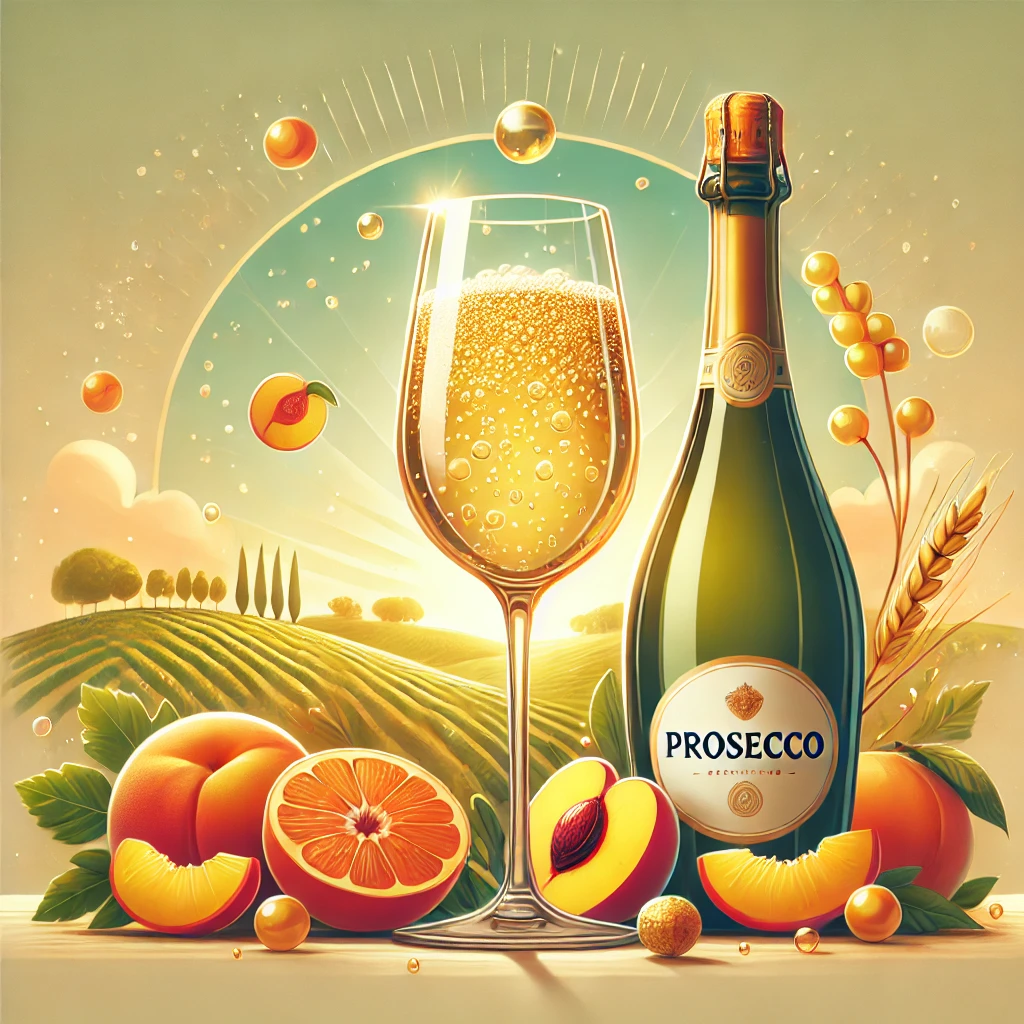What is Prosecco? A Guide to Italy’s Popular Sparkling Wine
Prosecco is a sparkling white wine that originates from the northeastern region of Italy, primarily in the areas of Veneto and Friuli Venezia Giulia. Known for its light, fruity flavor and affordability, Prosecco has gained worldwide popularity as a refreshing alternative to Champagne. Made primarily from the Glera grape, Prosecco is a versatile wine enjoyed in cocktails, as an aperitif, or simply on its own.
In this guide, we’ll explore Prosecco’s origins, production process, styles, and tips for enjoying this sparkling favorite.
1. Origins and History of Prosecco
Prosecco’s history dates back to ancient Rome, when a wine called “Puccino” was produced in northeastern Italy and enjoyed by the Romans. Over centuries, the wine evolved, and by the 18th century, the Glera grape became the primary grape used for Prosecco, defining its flavor and style.
The name “Prosecco” itself is derived from a small Italian village near Trieste, which contributed to the wine’s identity. Since then, Prosecco has grown into one of Italy’s most beloved exports, and in recent decades, it has become a global phenomenon. In 2009, Italy granted Denominazione di Origine Controllata (DOC) status to Prosecco, ensuring that only wines produced in specific regions could be labeled as Prosecco, thus protecting its identity and quality standards.
2. How Prosecco is Made: The Charmat Method
Unlike Champagne, which is made using the traditional method (or “Méthode Champenoise”), Prosecco is typically made using the Charmat method, also known as the tank method. This process is faster and less labor-intensive, which contributes to Prosecco’s affordability.
Steps of the Charmat Method:
- Fermentation in Stainless Steel Tanks: The base wine undergoes a secondary fermentation in large, pressurized stainless steel tanks, where carbon dioxide is trapped, creating bubbles.
- Yeast and Sugar Addition: During the second fermentation, yeast and sugar are added, producing natural carbonation.
- Bottling: Once the desired pressure and flavor profile are achieved, the wine is filtered, bottled, and sealed.
This method enhances Prosecco’s fresh, fruity flavors, making it light and approachable with lively bubbles. Prosecco’s floral and fruity notes are less complex than those of Champagne, but they offer a refreshing taste profile that appeals to a wide range of palates.
3. Types of Prosecco
Prosecco comes in various styles and sweetness levels, with differences in bubble intensity, sweetness, and alcohol content.
a. Prosecco DOC and Prosecco DOCG
- Prosecco DOC: The more widely available version, made in the Veneto and Friuli Venezia Giulia regions, encompassing a broad range of qualities.
- Prosecco DOCG: A premium Prosecco from two specific regions: Conegliano Valdobbiadene and Asolo. These wines have stricter production standards, ensuring high quality and are considered some of the finest Proseccos available.
b. Sweetness Levels
Prosecco is available in varying sweetness levels, from the driest (Brut) to the sweetest (Demi-Sec).
- Brut: The driest style, with less than 12 grams of sugar per liter. This type is crisp and less sweet, ideal for those who prefer a drier profile.
- Extra Dry: Slightly sweeter than Brut, with 12-17 grams of sugar per liter. It is the most common Prosecco style, balancing sweetness and acidity.
- Dry: Despite the name, this version is quite sweet, with 17-32 grams of sugar per liter.
- Demi-Sec: The sweetest Prosecco, often enjoyed as a dessert wine due to its high sugar content.
c. Bubble Styles
Prosecco can be classified by the level of carbonation:
- Spumante: The most bubbly version, similar to Champagne in carbonation level.
- Frizzante: Lightly sparkling, with a gentler fizz that is more delicate.
- Tranquillo: Still Prosecco with no carbonation, a rare style typically enjoyed by locals in Italy.
4. Tasting Notes and Flavor Profile
Prosecco’s flavor profile is primarily defined by its freshness and fruity notes. Common tasting notes include green apple, pear, white peach, melon, and floral hints like honeysuckle. The Charmat method enhances these fresh, fruity qualities, giving Prosecco its bright, approachable taste.
Higher-quality Prosecco, particularly DOCG wines, may also display mineral and herbal notes, adding complexity. Prosecco is typically light-bodied, with a moderate alcohol content around 11%, making it ideal for casual sipping.
5. Prosecco vs. Champagne: Key Differences
While Prosecco and Champagne are both sparkling wines, they differ in terms of production methods, flavor profiles, and price points. Here’s a comparison:
- Production Method: Champagne is made using the traditional method, involving a second fermentation in the bottle, while Prosecco uses the Charmat method in large tanks, resulting in simpler, fruitier flavors.
- Flavor Profile: Champagne has complex flavors with notes of brioche, almonds, and citrus, while Prosecco is known for its fresh, fruit-forward notes of apple, pear, and melon.
- Price: Prosecco is generally more affordable than Champagne due to its production process. While high-end Prosecco DOCG can be more expensive, most Prosecco options are budget-friendly.
6. Serving and Pairing Prosecco
Prosecco is best enjoyed chilled, between 6-8°C (43-46°F). Its light, refreshing taste makes it versatile for various occasions, from casual gatherings to celebrations.
Food Pairing
Prosecco’s fruity flavors and crisp acidity make it an excellent pairing with a variety of foods. Here are some classic pairings:
- Appetizers: Light cheeses, prosciutto, olives, and bruschetta.
- Seafood: Its acidity complements seafood dishes like oysters, shrimp, and sushi.
- Italian Cuisine: Prosecco pairs wonderfully with Italian dishes like pasta, risotto, and pizza, balancing flavors without overwhelming the palate.
- Desserts: Sweeter Proseccos (like Demi-Sec) pair well with fruit tarts, cheesecakes, and panna cotta.
Prosecco Cocktails
Prosecco is commonly used in cocktails due to its light flavor and affordability. Popular cocktails include:
- Bellini: Prosecco mixed with peach puree, a classic Italian cocktail.
- Aperol Spritz: Prosecco, Aperol, and soda water, served with an orange slice—a popular choice for warm weather.
- Mimosa: Prosecco mixed with orange juice, a brunch favorite.
7. Tips for Choosing and Storing Prosecco
When choosing Prosecco, consider the DOC or DOCG label for quality assurance. DOCG Prosecco from Conegliano Valdobbiadene or Asolo is typically higher in quality. Additionally, Prosecco is best enjoyed fresh, so it’s recommended to consume it within two years of bottling for optimal flavor.
Storage:
- Keep it Chilled: Store Prosecco in a cool, dark place, ideally in a wine fridge. Once opened, Prosecco should be consumed within a day or two to maintain its carbonation and flavor.
- Avoid Long-Term Aging: Unlike Champagne, most Proseccos do not benefit from long-term aging. Drinking it within a short time frame preserves its fresh, fruity notes.
Conclusion
Prosecco’s versatility, refreshing flavor, and affordability have made it a favorite sparkling wine worldwide. With various sweetness levels, styles, and types, Prosecco offers something for every palate, making it a delightful choice for casual sipping, celebrations, and pairing with a range of dishes.
Whether you’re toasting with a glass of classic Brut Prosecco or enjoying a fruity Bellini cocktail, Prosecco provides a taste of Italian tradition with a modern twist. Its approachable style and vibrant character continue to charm wine lovers, proving that sometimes, simplicity is key to true enjoyment.






